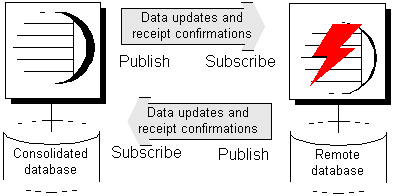 Data Replication with SQL Remote
Data Replication with SQL Remote
 PART 1. Introduction to SQL Remote
PART 1. Introduction to SQL Remote
 CHAPTER 2. SQL Remote Replication Concepts
CHAPTER 2. SQL Remote Replication Concepts
The data that is replicated by SQL Remote is arranged in publications. Each database that shares information in a publication must have a subscription to the publication.
The publication is a database object describing data to be replicated. Remote users of the database who wish to receive a publication do so by subscribing to a publication.
A publication may include data from several database tables. Each table's contribution to a publication is called an article. Each article may consist of a whole table, or a subset of the rows and columns in a table.

Periodically, the changes made to each publication in a database are replicated to all subscribers to that publication. These replications are called publication updates.
Remote databases subscribe to publications on the consolidated database so that they can receive data from the consolidated database. To do this, a subscription is created at the consolidated database, identifying the subscriber by name and by the publication they are to receive.
SQL Remote always involves messages being sent two ways. The consolidated database sends messages containing publication updates to remote databases, and remote databases also send messages to the consolidated database.
For example, if data in a publication at a consolidated database is updated, those updates are sent to the remote databases. And even if the data is never updated at the remote database, confirmation messages must still be sent back to the consolidated database, to keep track of the status of the replication.
Messages must be sent both ways, so not only does a remote database subscribe to a publication created at the consolidated database, but the consolidated database must subscribe to a corresponding publication created at the remote database.

When remote database users modify their own copies of the data, their changes are replicated to the consolidated database. When the messages containing the changes are applied at the consolidated database the changes become part of the consolidated database's publication, and are included in the next round of updates to all remote sites (except the one it came from). In this way, replication from remote site to remote site takes place via the consolidated database.
When a subscription is initially set up, the two databases must be brought to a state where they both have the same set of information, ready to start replication. This process of setting up a remote database to be consistent with the consolidated database is called synchronization. Synchronization can be carried out manually, but the database extraction utility automates the process. You can run the extraction utility from Sybase Central or as a command-line utility.
The appropriate publication and subscription are created automatically at remote databases when you use the SQL Remote database extraction utility to create a remote database.